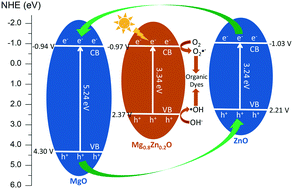当前位置:
X-MOL 学术
›
CrystEngComm
›
论文详情
Our official English website, www.x-mol.net, welcomes your
feedback! (Note: you will need to create a separate account there.)
Mg0.8Zn0.2O microspheres: preparation, characterization and application for degrading organic dyes
CrystEngComm ( IF 2.6 ) Pub Date : 2020/01/03 , DOI: 10.1039/c9ce01717h Yajun Zheng 1, 2, 3, 4, 5 , Liyun Cao 5, 6, 7, 8 , Gaoxuan Xing 1, 2, 3, 4, 5 , Jianfeng Huang 5, 6, 7, 8 , Zhiping Zhang 1, 2, 3, 4, 5
CrystEngComm ( IF 2.6 ) Pub Date : 2020/01/03 , DOI: 10.1039/c9ce01717h Yajun Zheng 1, 2, 3, 4, 5 , Liyun Cao 5, 6, 7, 8 , Gaoxuan Xing 1, 2, 3, 4, 5 , Jianfeng Huang 5, 6, 7, 8 , Zhiping Zhang 1, 2, 3, 4, 5
Affiliation

|
Photocatalytic degradation of organic pollutants in wastewater is one of the most promising strategies for environmental remediation, and photocatalysts as the prerequisite have received considerable attention. Herein we reported highly efficient, nontoxic, and inexpensive Mg0.8Zn0.2O microspheres with a diameter of around 36 μm prepared through reaction between CO32−, Mg2+ and Zn2+ for degrading organic dyes. The molar ratio between Mg2+ and Zn2+ was found to play a crucial role in determining the morphology and photocatalytic performance of the resulting product. According to time-dependent experiments, the plausible formation mechanism for the spherical-like Mg0.8Zn0.2O composite was proposed, in which irregular agglomerates composed of fine powders were first formed followed by their transformation into rod-like structures. Due to their thermal instability, the rod-like particles underwent further self-assembly and became a more stable spherical-like product with ZnCO3 embedded in the space between Mg5(CO3)4(OH)2·4H2O sheets. After investigating the photocatalytic performance, the results demonstrated that the developed Mg0.8Zn0.2O composite was not only superior to other state-of-the-art catalysts such as P25 TiO2 and g-C3N4 in degrading organic dyes upon irradiation under either UV light or visible light, but also was an amphoteric photocatalyst more favorable for degrading organic dyes in both strongly acidic (pH 2–4) and strongly alkaline (pH 12) solutions. Moreover, its catalytic efficiency remained as high as 98.3% after six cycles. These features made the developed Mg0.8Zn0.2O composite promising in practical utilization for treatment of organic dyes. Further experiments including photoluminescence, adsorption and photoelectrochemical measurements accounted for the underlying photocatalytic mechanism of the Mg0.8Zn0.2O composite for degradation of organic dyes.
中文翻译:

Mg0.8Zn0.2O微球:降解有机染料的制备,表征及应用
废水中有机污染物的光催化降解是最有前途的环境修复策略之一,作为前提的光催化剂受到了广泛关注。本文中,我们报道了通过CO 3 2-,Mg 2+和Zn 2+之间的反应制备的用于降解有机染料的高效,无毒且廉价的Mg 0.8 Zn 0.2 O微球,直径约36μm 。Mg 2+与Zn 2+的摩尔比发现在确定所得产物的形态和光催化性能方面起着至关重要的作用。根据随时间变化的实验,提出了球形Mg 0.8 Zn 0.2 O复合材料的合理形成机理,该方法首先形成由细粉组成的不规则团聚体,然后将其转变为棒状结构。由于其热不稳定性,棒状颗粒进一步自组装,并成为更稳定的球形产品,其中ZnCO 3嵌入在Mg 5(CO 3)4(OH)2 ·4H 2之间的空间中O张。在研究了光催化性能之后,结果表明,所开发的Mg 0.8 Zn 0.2 O复合材料不仅能在其他条件下照射后降解有机染料,而且优于P25 TiO 2和gC 3 N 4等其他最新催化剂。紫外线或可见光,也是一种两性光催化剂,在强酸性(pH 2-4)和强碱性(pH 12)溶液中都更适合降解有机染料。而且,在六个循环后,其催化效率仍高达98.3%。这些特性使已开发的Mg 0.8 Zn 0.2一种有望在有机染料的处理中得到实际应用的复合材料。包括光致发光,吸附和光电化学测量在内的进一步实验说明了Mg 0.8 Zn 0.2 O复合材料降解有机染料的潜在光催化机理。
更新日期:2020-02-17
中文翻译:

Mg0.8Zn0.2O微球:降解有机染料的制备,表征及应用
废水中有机污染物的光催化降解是最有前途的环境修复策略之一,作为前提的光催化剂受到了广泛关注。本文中,我们报道了通过CO 3 2-,Mg 2+和Zn 2+之间的反应制备的用于降解有机染料的高效,无毒且廉价的Mg 0.8 Zn 0.2 O微球,直径约36μm 。Mg 2+与Zn 2+的摩尔比发现在确定所得产物的形态和光催化性能方面起着至关重要的作用。根据随时间变化的实验,提出了球形Mg 0.8 Zn 0.2 O复合材料的合理形成机理,该方法首先形成由细粉组成的不规则团聚体,然后将其转变为棒状结构。由于其热不稳定性,棒状颗粒进一步自组装,并成为更稳定的球形产品,其中ZnCO 3嵌入在Mg 5(CO 3)4(OH)2 ·4H 2之间的空间中O张。在研究了光催化性能之后,结果表明,所开发的Mg 0.8 Zn 0.2 O复合材料不仅能在其他条件下照射后降解有机染料,而且优于P25 TiO 2和gC 3 N 4等其他最新催化剂。紫外线或可见光,也是一种两性光催化剂,在强酸性(pH 2-4)和强碱性(pH 12)溶液中都更适合降解有机染料。而且,在六个循环后,其催化效率仍高达98.3%。这些特性使已开发的Mg 0.8 Zn 0.2一种有望在有机染料的处理中得到实际应用的复合材料。包括光致发光,吸附和光电化学测量在内的进一步实验说明了Mg 0.8 Zn 0.2 O复合材料降解有机染料的潜在光催化机理。











































 京公网安备 11010802027423号
京公网安备 11010802027423号